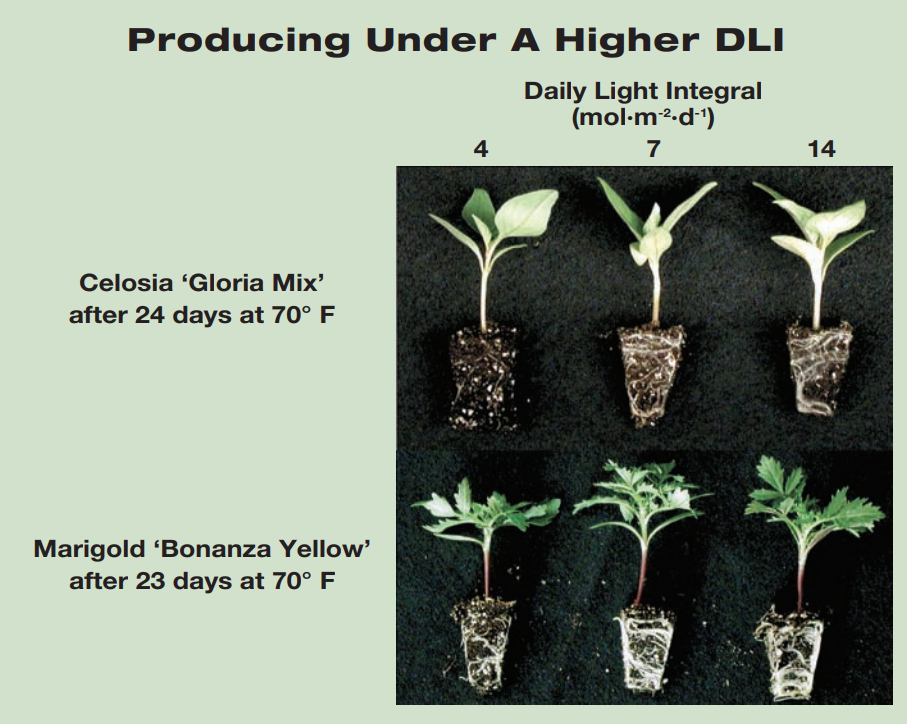
The benefits of lighted plugs
DOWNLOADMarch 24, 2007 - E. Runkle
technically speaking By Erik Runkle
The Benefits Of Lighted Plugs
One of the most cost-effective uses of supplemental lighting is during the production of seedling plugs and rooted liners. Learn how high daily light integrals benefit plants.
Supplemental
lighting is increasingly being used in the northern half of the United States and in Canada. One of the most cost-effective uses of supplemental lighting is during the production of seedling plugs and rooted liners. Light provides the energy for plant growth and development, including the energy needed to produce leaves, flowers and roots. Most seedling plugs grown under low light levels (such as an average daily light integral (DLI) less than 8 mol·m-2·d-1) are of inferior quality to plugs grown under a higher DLI. Plugs grown under a low DLI take longer to become “pullable,” have more succulent growth and have weaker stems with less branching
A few years ago, my former graduate student Lee Ann Moccaldi quantified the impacts of DLI on the quality and subsequent finish times of 288-cell plugs of several common bedding plants. She grew seedlings of celosia, impatiens, marigold, pansy and salvia at a constant 70° F under a 16-hour photoperiod and a DLI from 4 to 14 mol·m-2·d-1. This range of DLI represents typical values in greenhouses in the northern United States from December to March. After 23-31 days from seed sow (depending on species), plugs were transplanted and grown in a common environment at 70° F with a 16-hour photoperiod and a DLI of 8.5 mol·m-2·d-1. Time to flowering and flowering characteristics were then quantified on the date that each plant first flowered.
Experiment Results
Not surprisingly, seedling plug quality increased as the DLI under which it was grown increased. We quantified plant quality as the amount of dry matter produced per node (the distance from one leaf to the next). This gave us an indication of the bulk of stems and leaves. Plant quality increased 47-68 percent in all species studied. In other words, stems and leaves of seed impatiens produced 47 percent more plant tissue when grown under a DLI of 14 mol·m-2·d-1 compared to 4 mol·m-2·d-1 while pansy produced 68 percent more vegetative growth. When the seedlings were pulled from their plug trays for transplanting, it was obvious the plugs also produced more roots when grown under a higher DLI (see Figure 1).
The DLI during the plug stage also influenced subsequent flowering time. Plants flowered progressively earlier as the DLI during the plug stage increased, until around 12-14 mol·m-2·d-1. For example, as the DLI during the plug stage increased from 5 to 10 mol·m-2·d-1, flowering was accelerated by three days in marigold, five days in celosia and salvia, and eight days in impatiens and pansy. In other words, crop finish times can vary by as much as eight days if your plugs are grown under a low DLI compared with a moderate DLI.
Although the plugs grown under the higher DLIs flowered earlier, most species produced fewer flowers and were smaller at first flowering compared with plugs that were grown under a lower DLI and took longer to flower. At first, this seems counterintuitive. However, because plants grown under a lower DLI took longer to flower, they had a longer period of time to harvest light for photosynthesis before flowering. Therefore, it seems logical that the longer the production time, the higher the flower count and the larger the shoot. If the dry weight and flower count of finish plants was measured on the same date, likely those initially under a higher DLI would have been similar to or greater than plants grown under a lower DLI.

Take-Home Message
Plugs produced under a moderate DLI (10-14 mol·m-2·d-1) had a better root system and greater plant mass compared to plugs grown under a low DLI. The DLI during the plug stage also had a carryover effect on the finish stage. Plugs under the moderate DLIs flowered earlier than plugs under a low DLI but generally had fewer flowers at first flowering. Therefore, growers who want to produce crops rapidly may want to consider using plugs grown under at least a moderate DLI for rapid finish times.
Erik Runkle is assistant professor and floriculture extension specialist in the Department of Horticulture at Michigan State University, East Lansing, Mich. He can be reached at runkleer@msu.edu or (517) 355-5191.



 Print
Print Email
Email





